Ugali
Ugali, also known as ugali pap, nsima and nshima, is a type of maize flour porridge made in Africa.[1] It is also known as ngima, obusuma, kimnyet, nshima, mieliepap, phutu, sadza, kwon, isitshwala and other names. Nsima is sometimes made from other flours, such as millet or sorghum flour, and is sometimes mixed with cassava flour. It is cooked in boiling water or milk until it reaches a stiff or firm dough-like consistency.[2]
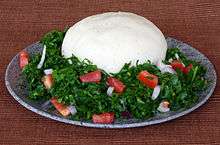 Ugali and sukuma wiki (collard greens) | |
| Type | Porridge |
|---|---|
| Place of origin | Kenya |
| Main ingredients | Cornmeal, mealie-meal (white maize) |
| Similar dishes | |
Names
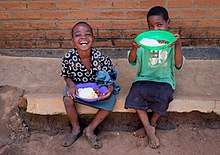
This dish is eaten widely across Africa, where it has different local names:
- Akamu – Igbo, Nigeria
- Arega - Kenya, Luo
- Bando - Soga, Uganda
- Bidia – DR Congo[3]
- Bogobe/Phaletšhe – Botswana, South Africa
- Bugali – Burundi, DR Congo, Sudan, South Sudan Rwanda
- Buhobe – Lozi[4]
- Buru – Kenya, Luo
- Busima-Bagisu, Uganda
- Chenge – Kenya, Luo
- Chima – Mozambique
- Couscous de Cameroon – Cameroon
- Dona
- Fitah - Sudan, South Sudan, Congo
- Fufu - Sierra Leone
- Isitshwala – Botswana, Ndebele
- Kawunga - Ganda, Uganda
- Kimnyet – Kalenjin, Kenya
- Kuon – Kenya, Luo
- Kwen wunga - Alur, Uganda
- Lipalishi – Eswatini
- Mielie pap – Lesotho,[3] South Africa[3][5]
- Mogo – Kenya, Luo
- Moteke – DR Congo[3]
- Mutuku – South Africa[3]
- Nfundi – Congo[3]
- Ngima – Kamba, Kenya, Kikuyu
- Nkima – Kenya, Meru
- Nshima- DR Congo Kasai region
- Nsima – Malawi,[3] Zambia[3]
- Obokima – Kenya, Sudan Kisii
- Obusuma – Kenya, Nyole[6]
- Ogi – Nigeria, Yoruba
- Oshifima – Namibia
- Pap – Namibia, South Africa[7]
- Papa – Lesotho,[3] South Africa[3]
- Pate – Togo
- Phaletšhe – Botswana
- Phuthu – South Africa[8]
- Posho – Uganda[9]
- Poshto – Uganda
- Saab – Ghana, Kusasi
- Sadza – Shona and Kalanga, Zimbabwe and Botswana[3][10]
- Sakora – Nigeria
- Sakoro – Ghana
- Sembe - Tanzania, slang
- Sembe – Kenya, slang
- Shadza – Kalanga, Botswana
- Shima
- Shishima - Zambia
- Sima – Chewa,[11] Tumbuka, and Ngoni[4]
- Soor – Somalia,[3] Zambia[3]
- Tuozafi (or T.Z.) – Ghana
- Ubugali – Rwanda
- Ubwali – Bemba[4]
- Ugali – Kenya,[3], Malawi, Mozambique, Tanzania,[3] Uganda,[3] Yao, Swahili
- Um'ratha – Ndebele
- Upswa – Mozambique[3]
- Vbogobe – Sotho, Tswana
- Vhuswa – Venda
- Xima – Mozambique[3]
Etymology
The word ugali is a Bantu language term derived from Swahili, it is also widely known as nsima in Malawian languages such as Chichewa and Chitumbuka. In parts of Tanzania, the dish also goes by the informal, "street" name of nguna or donee.[12]
History
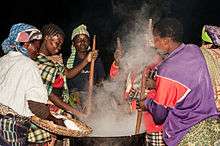
Maize was introduced to Africa from the Americas between the 16th and 17th century. Before this, sorghum and millet were the staple cereals in most of Sub-Saharan Africa. Maize was readily accepted by African farmers as its cultivation was very similar to that of sorghum but with significantly higher yields. Eventually, maize displaced sorghum as the primary cereal in all but the drier regions. The full replacement of these crops with maize took place in the latter half of the twentieth century.[13] In Malawi, they have a saying 'chimanga ndi moyo' which translates to 'maize is life'.[14] Nshima/nsima is still sometimes made from sorghum flour though it is quite uncommon to find this. Cassava, which was also introduced from the Americas, can also be used to make nshima/nsima, either exclusively or mixed with maize flour. In Malawi nsima made from cassava (chinangwa) is localized to the lakeshore areas, however, when maize harvests are poor, cassava nsima can be found all over the country.[15]
Varieties
African Great Lakes
Ugali (when it is cooked as porridge, it is called uji) is usually served with stew or sukumawiki (also known as kale). It is the most common staple starch featured in the local cuisines of the African Great Lakes region and Southern Africa. When ugali is made from another starch, it is usually given a specific regional name.[16]
The traditional method of eating ugali (and the most common in the rural areas) is to roll a lump into a ball with the right hand, and then dip it into a sauce or stew of vegetables or meat. Making a depression with the thumb allows the ugali to be used to scoop, and to wrap around pieces of meat to pick them up in the same way that flatbread is used in other cultures. Leftover ugali can also be eaten with tea the following morning.[17]
Ugali is relatively inexpensive and thus easily accessible to the poor, who usually combine it with a meat or vegetable stew (e.g., sukuma wiki in Kenya) to make a filling meal. Ugali is easy to make, and the flour can last for a considerable time in average conditions.
Ghana
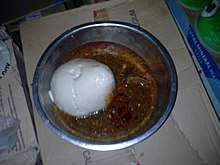
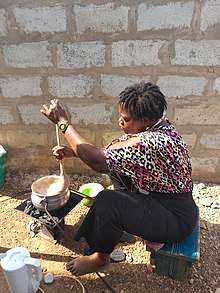
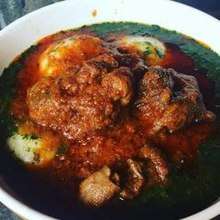
Sagtulga (Hausa:tuo zaafi), or diehuo is a popular main dish for the people of Ghana. Sagtulga is a main meal eaten with soupy accompaniments such as okro soup. It is most common in the country's three northern regions which are: Northern Region, Upper East Region, and Upper West Region. The dish is usually eaten for dinner, yet some people (for example: farmers and manual workers) like to have it for breakfast or lunch. It is usually eaten with blended Corchorus olitorius leaves (Dagbani:Salinvogu, Hausa:Ayoyo, Molokai) [18] and okro (Abelmoschus esculentus)[19] with stew on the side.
The dish consists of cooked Maize dough with a little dried cassava dough and water without salt.[20] Traditionally, it is prepared with millet dough[21] which is indigenous to Ghana's north.[22]
It is mainly eaten with green vegetable soup made from bitter leaves, or sometimes freshly pounded cassava leaves. It can be accompanied, however, with a variety of soups including okra and groundnut soup.
It is prepared by boiling water or fermented dough water in a stainless steel saucepan. When the water on fire is simmering mix corn-dough with water and pour while stirring into the boiling water to make corn porridge. Cover the porridge to boil for sometime and then fetch about half of the porridge down in a bowl to be incorporated into the pot later. Using the remaining porridge in the saucepan on fire, pour dried corn flour or millet flour into the porridge while stirring consistently till the porridge becomes very thick. Keep stirring the thick mixture while adding the remaining porridge from time to time.[23][24][25]
Kenya
In Luhya culture it is the most common staple starch, but is also a key part of Luhya Wedding traditions; obusuma prepared from millet (known as obusuma bwo bule) was traditionally included among delicacies on a bride's high table. Obusuma can also be prepared from other starches like sorghum or cassava (obusuma bwo 'muoko). Obusuma is commonly served with tsimboka, or etsifwa, Eliani (vegetables), inyama, (meat), inyeni, (fish), thimena, (whitebait) or omrere (jute leaves). For distinguished guests or visitors, it is usually served with ingokho, (chicken).
Malawi, Zambia
Nsima is a dish made from maize flour (white cornmeal) and water and is a staple food in Zambia (nshima/ nsima) and Malawi (nsima).[26]
The maize flour is first boiled with water into a porridge.[27] It is then 'paddled,' to create a thick paste with the addition of more flour. This process requires the maker to pull the thick paste against the side of a pot with a flat wooden spoon (called an nthiko) quickly whilst it continues to sit over the heat. Once cooked the resulting nshima/nsima is portioned using a wooden/plastic spoon dipped in water or coated in oil called a chipande, each of these portions is called an ntanda.[27]
Nshima is almost always eaten with two side dishes, known as "relishes":[4] a protein source: meat, poultry, fish, groundnuts (peanuts), beans; and a vegetable, often rape leaves, pumpkin leaves, amaranth leaves, mustard leaves or cabbage. The protein sides are known as Ndiyo (Zambia) or Ndiwo (Malawi), and the vegetable sides are known as masambaor "umuto wankondwa" in Zambia. In Malawi, this is often accompanied with hot peppers or condiments like homemade hot pepper sauces from peri-peri or Kambuzi chili peppers or commercial chili sauces like Nali Sauce. Traditionally diners sit around a table or on the floor surrounding the meal. The diners have to wash their hands as nshima/nsima is eaten with bare hands. This is done with a bowl of water. Alternatively the host or one of the younger people present pours water from a jug over the hands of the elders or guests into a bowl. Eating is done by taking a small lump into one's right palm, rolling it into a ball and dipping it into the relish. An indentation in the ball can be made to help scoop the relish or soup. As with many African traditions, age is very important. Washing before the meal, eating, and washing after the meal generally starts with the oldest person, followed by everyone else in turn by age.
Nshima/nsima is relatively cheap and affordable for most of the population, although occasionally prices have risen due to shortages, contributing to economic and political instability.
In Malawi, it is normally eaten with utaka – a type of local dried fish.
Nigeria
In Nigeria, akamu or ogi has a consistency similar to that of American pudding.[28][29] Ogi/Akamu in Nigeria is generally accompanied with "moin moin" a bean pudding or "akara" which is a bean cake.
South Africa
Pap /ˈpɑːp/, also known as mieliepap (Afrikaans for maize porridge) in South Africa, is a traditional porridge/polenta made from mielie-meal (coarsely ground maize) and a staple food of the Bantu peoples of Southern Africa (the Afrikaans word pap is taken from Dutch and means merely "porridge"). Many traditional Southern African dishes include pap, such as smooth maize meal porridge (also called slap pap or soft porridge), pap with a very thick consistency that can be held in hand (stywe pap or firm porridge) and a more dry crumbly phuthu pap. Phuthu dishes are usually found in the coastal areas of South Africa.[30]
A variety of savouries can be used to accompany pap, made from green vegetables, and flavored with chili.
South Africans in the northern parts of South Africa eat it as the breakfast staple, with milk, butter, and sugar, but also serve it with meat and tomato stew (usually tomato and onion) at other meals. When they have a braai, Bogobe or "Stywe" pap with a savoury sauce like tomato and onion or mushroom is an important part of the meal. Phutu pap is popularly served with boerewors, a combination that later became known as pap en wors (also called "pap en vleis").[31]
In the Cape Province of South Africa, it is almost exclusively seen as a breakfast food. Since mielie-meal is inexpensive, poor people combine it with vegetables. It can be served hot or, after it has cooled, it can be fried. Phutu porridge is sometimes enjoyed with chakalaka as a side dish with braais.[32]
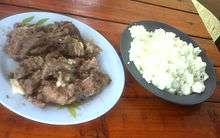
Uphuthu is a South African method of cooking mealie meal whereby the end product is a finely textured coarse grain-like meal which is typically enjoyed with an accompaniment of vegetables and meat in Kwa Zulu Natal and Eastern Cape regions of South Africa or as the star of the dish with amasi or maas in the Gauteng regions. Some cultures add sugar to uphuthu and amasi to enjoy it as a sweet treat that would resemble cereal, however the corn-based stable is typically enjoyed as is with amasi.
Phuthu or Uphuthu (/ˈpʊtuː/), also incorrectly spelled as putu or phutu, is a traditional preparation method of maize meal in South African cuisine. It is a crumbly or grainy type of pap or porridge, eaten by most cultural groups in South Africa. Phuthu is often eaten with meat, beans, gravy and sour milk.
Phutu South Africa / Basotho, Nguni, Afrikaner
Zimbabwe
_(Phaleche)_7.jpg)
Sadza in Shona (isitshwala in isiNdebele, or pap, vuswa or bogobe in South Africa, or nsima in the Chichewa language, or Ugali in Kenya) or phaletšhe in Botswana, is a cooked maize meal that is the staple food in Zimbabwe and other parts of Southern Africa.[33]
Sadza is made with finely ground dry maize/corn maize (Mealie-Meal). This maize meal is referred to as hupfu in Shona or impuphu in Ndebele. Despite the fact that maize is an imported food crop to Zimbabwe (c. 1890), it has become the chief source of carbohydrate and the most popular meal for indigenous people. Locals either purchase the mealie meal in retail outlets or produce it in a grinding mill from their maize.
Zimbabweans prefer white maize meal. However, during times of famine or hardship, they resorted to eating yellow maize meal, which is sometimes called "Kenya," because it was once imported from that nation. Before the introduction of maize, sadza was made from zviyo finger millet.
Sadza is typically served on individual plates, but traditionally sadza was eaten from a communal bowl, a tradition that is still maintained by some families mainly in the rural areas. It is generally eaten with the right hand without the aid of cutlery; often rolled into a ball before being dipped into a variety of condiments such as sauce/gravy, sour milk, or stewed vegetables.[34]
Notable foods eaten with sadza include:
Meat is known as nyama in Shona.
- Red meat – includes beef, mutton, goat (mbudzi ın Shona), and game meat
- Cow hoof – amanqgina, mazondo
- Oxtail
- Other food stuff include intestine (tripe), offal, ezangaphakathi (includes amathumbu, amaphaphu, isibindi, utwane, ulusu, umbendeni; in Ndebele known as matumbu), sun-dried vegetables known as uMfushwa/Mufushawa, and many more
- White meat – includes huku or inkukhu - chicken meat, hove - Fish
- Fish (inhlanzi in Ndebele), including the small dried fish Kapenta
- Mopane worms / madora / amacimbi – edible moth caterpillar
- Spring greens – known as imibhida in the Ndebele Language, muriwo in the Shona Language
- Sugar Beans – known as indumba in Ndebele, nyemba Shona
- Cabbage
- Derere Delele – okra
- Cleome gynandra (ulude in Ndebele) / nyevhe in Shona
- Pumpkin – leaves known as Muboora in shona or ibhokola in Ndebele
- Soured milk natural yogurt (known as amasi in Ndebele or Nguni languages in South Africa, mukaka wakakora in Shona, or lacto
- Soya Chunks
- Soups and stews
- Sadza and ox bone
Similar dishes
Similar dishes are polenta, from northern Italy, and grits in the southern United States.
Fufu, a starch-based food from West and Central Africa, may also be made from maize meal, in which case it may be called fufu corn. In the Caribbean, similar dishes are cou-cou (Barbados), funchi (Curaçao), and funjie (Virgin Islands). It is known as funche in Puerto Rican cuisine and mayi moulin in Haitian cuisine.[35]
Dishes similar to pap include banku, isidudu, uphuthu, umpokoqo and umngqusho.
Gallery
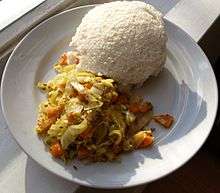 Ugali and cabbage
Ugali and cabbage Phutu, pictured with tomato-based relish in the foreground
Phutu, pictured with tomato-based relish in the foreground- A meal of sadza (right), greens, and goat offal. The goat's small intestines are wrapped around small pieces of large intestines before cooking.
 Ugali and usipa (small fish), staples of the Yawo people of the African Great Lakes.
Ugali and usipa (small fish), staples of the Yawo people of the African Great Lakes.
See also
- Dhindo - a very similar preparation from Nepal
- Chapati
- Cornmeal
- Fufu (suji)
- Grits
- Idli
- Malawian cuisine
- Moi-moi
- Mămăliga
- Polenta
- Tuareg food
- List of African dishes
- List of maize dishes
- List of porridges
- List of soups

References
Citations
- "Ugali - a Kenyan cornmeal porridge". Taste Of The Place. 16 October 2017. Retrieved 23 August 2018.
- "How to prepare ugali/posho". Yummy. 4 May 2015. Retrieved 23 August 2018.
- McCann 2009, p. 137.
- Tembo, Mwizenge S. "Nshima and Ndiwo: Zambian Staple Food". Hunger For Culture. Archived from the original on 24 February 2017. Retrieved 18 February 2018.
- "Mealiepap, n." Dictionary of South African English. Dictionary Unit for South African English, 2018. 25 February 2019
- "Kenya Information Guide Home page". Retrieved 24 June 2013.
- "Pap, n." Dictionary of South African English. Dictionary Unit for South African English, 2018. 25 February 2019.
- "Putu, n." Dictionary of South African English. Dictionary Unit for South African English, 2018. 25 February 2019.
- "Ugandan food recipes - POSHO (UGALI) - Wattpad". www.wattpad.com. Retrieved 23 August 2018.
- "Sadza, n." Dictionary of South African English. Dictionary Unit for South African English, 2018. 25 February 2019
- Gough, Amy (2004). "The Chewa". The Peoples of The World Foundation. Retrieved 18 February 2018.
- "Tanzanian Ugali / Nguna Recipe". Gayathri's Cook Spot. 1 September 2015. Retrieved 23 August 2018.
- McCann 2009, p. 139.
- "Food & Daily life". Our Africa. Retrieved 7 May 2015.
- Emma Kambewa (November 2010). "Cassava Commercialization in Malawi" (PDF) (MSU International Development Working Paper). Archived from the original (PDF) on 4 March 2016.
- "HOW TO COOK THE PERFECT UGALI / Nairobi Kitchen". HOW TO COOK THE PERFECT UGALI / Nairobi Kitchen. 15 July 2017. Retrieved 19 May 2020.
- App, Daily Nation. "Fancy a piece of ugali cake with your tea?". mobile.nation.co.ke. Retrieved 29 May 2020.
- https://pfaf.org/user/Plant.aspx?LatinName=Corchorus+olitorius. Missing or empty
|title=(help) - https://en.m.wikipedia.org/wiki/Okra. Missing or empty
|title=(help) - "Ayoyo soup and tuo zaafi". infoboxdaily.com. Archived from the original on 27 May 2015. Retrieved 27 May 2015.
- Webb, L.S. (2000). Multicultural Cookbook of Life-Cycle Celebrations. Cookbooks for Students Series. Oryx Press. p. 64. ISBN 978-1-57356-290-4. Retrieved 2 October 2018.
- "An Introduction to Northern Ghana's Super Foods Shea, Millet & Fonio | Circumspecte". Circumspecte. 25 July 2016. Retrieved 20 June 2017.
- "Recipe: Tuozaafi & Ayoyo Stew". Modern Ghana. Retrieved 10 May 2020.
- "Recipe: Tuozaafi & Ayoyo Stew". Modern Ghana. Retrieved 10 May 2020.
- Wundengba, Charles (12 January 2019). "How to prepare Tuo Zaafi and Ayoyo soup". Northernghana.net. Retrieved 10 May 2020.
- "Nsima". CooksInfo. Retrieved 29 May 2020.
- "Nsima: The staple food of Malawi". experiencemalawi.com. Retrieved 7 May 2015.
- Kulp, Karel, editor. Handbook of Cereal Science and Technology, Second Edition, Revised and Expanded. ISBN 978-1-4200-2722-8. OCLC 1019722783.CS1 maint: multiple names: authors list (link)
- Kulp, Karel (28 March 2000). Handbook of Cereal Science and Technology, Second Edition, Revised and Expanded. CRC Press. ISBN 978-0-8247-8294-8.
- "Phutu Recipe (African Maize Flour Porridge)". EpersianFood. 7 April 2020. Retrieved 29 May 2020.
- "Best Procedure of Cooking Ugali Meal the kenyan way: Recipe". Kenyayote. 23 November 2017. Retrieved 26 May 2020.
- Rosengarten, David (3 October 2012). "Foods of South Africa: The Roots". Wine4Food. Retrieved 29 May 2020.
- "Traditional Plain Zimbabwean Sadza Recipe". Ethnic Foods R Us. Retrieved 24 May 2020.
- "Sadza". worldfood.guide.
- López, Ana Cristina Ballesteros author. Pereira, Accacia Julia Guimarães author. Junqueira, Roberto Gonçalves author. Flour mixture of rice flour, corn and cassava starch in the production of gluten-free white bread. OCLC 57094672.CS1 maint: multiple names: authors list (link)
Sources
- McCann, James C. (2009). Stirring the Pot: A History of African Cuisine. Athens, Ohio: Ohio University Press. ISBN 9780896802728.CS1 maint: ref=harv (link)
- South African Cuisine
- Basic phutu recipe
- What is Phuthu
The following books, set in Zimbabwe, discuss the characters' eating the Zimbabwean staple, sadza:
- Dangarembga, Tsitsi (1988). Nervous Conditions. Ayebia Clark Publishing. is a semi-autobiographical novel focused on the story of a Rhodesian family in post-colonial Rhodesia (present-day Zimbabwe), during the 1960s.
- In Douglas Rogers' book The Last Resort: A Memoir of Zimbabwe (September 2009), Naomi, an elderly Malawian woman whom Rogers calls "Mrs. John", brings her husband, John Muranda, the other John, John Agoneka, and Rogers bowls of warm sadza, which Rogers explains "Mrs. John" cooks daily, over a wood fire outside the Murandas' home. (Crown/Random House, LLC, ASIN: B002PXFYIS, Chapter 4, page 23).
External links
| Wikimedia Commons has media related to Ugali. |
